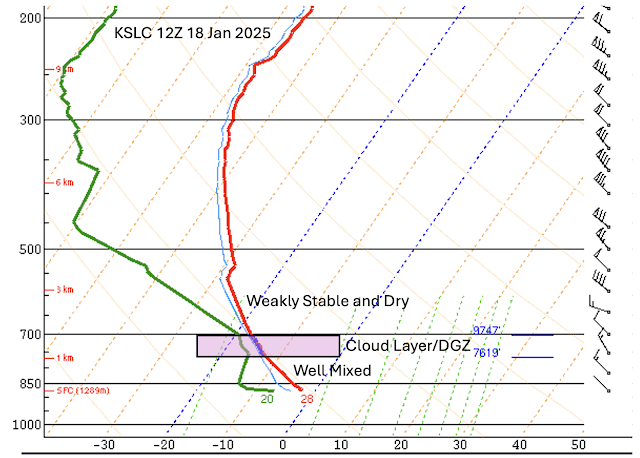The last few days, the ensembles have been producing a pretty wide range of possible forecast outcomes for the central Wasatch for the storm that begins tonight and extends, potentially, into Monday. This was discussed in the prior post (Shift in the Weather), and continues to be a forecast issue today.
Last night's Utah Snow Ensemble exhibits some spread in the forecasts through 0000 UTC 2 February (5 PM MST Saturday; red line below), but the means of the ECMWF ENS and GEFS ensembles are relatively similar and around 0.72" of water and 6.5" of high-density snow for Alta Collins. The latest GFS and HRRR are also around about 7" of snow, so going for something in the 5-10" range through 5 PM MST Saturday makes sense.
After that, the two ensemble systems diverge, with the ECMWF going for less water and snow than the GEFS, although there is some overlap of the members from each ensemble. The reason for this, and the uncertainty in the forecasts through Monday morning is uncertainty in the amplitude of the upper-level wave pattern and position of the atmospheric river and concomitant frontal system. The wave pattern in the wetter members, especially those in the GEFS ensemble, is less amplified, resulting in more zonal (west-to-east) flow and a longer period with the central Wasatch under the influence of the atmospheric river. In contrast, the wave pattern in the drier members, especially those in the ECMWF ensemble, is more amplified, resulting in a bit more southwesterly flow and a shorter peirod with the central Wasatch under the influence of the atmospheric river.
The ECMWF was actually drier a couple of days ago and it has shifted a bit more toward theGEFS and gotten a bit wetter. The EMCWF mean a couple of days ago was under and inch for the entire period, whereas now it is closer to 1.5 inches. Whether or not that trend will continue remains to be seen.
If you are into stats, we can look at some numbers from the Utah Snow Ensemble for Alta-Collins. We provide these at https://weather.utah.edu/text/ensgefsdslccforecast.html. In tables available at that link and reproduced for last nights run below, time increases to the right (local time is labeled). For each time, we provide the minimum, 10th percentile (P10), 25th percentile (P25), 50th percentile or medan (P50), 75th percentile (P75), 90th percentile (P90), and maximum accumulated water equivalent and accumulated snowfall (as well as other variables although I'm not presenting them here. These take a little while to wrap your head around, but one way to think about a percentile is that in the ensemble that percentage of the members is producing less than or equal to that amount. So, P25, or the 25th percentile means that 25% of the members are at or below that amount, whereas 75% are above it. For P75, 75% are at or below that amount, whereas 25% are above it.
For the latest forecast through Monday morning, P25 is 1.17" of water and 9.7" of snow. So, 25% of the members are at or below those amounts, whereas 75% are above it. The middle 50% of the ensemble (between P25 and P75) is between 1.17" and 2.35" of water.
Its not uncommon for forecasters to lean toward that range between P25 and P75. This middle 50% of the members is sometimes referred to as the interquartile range or IQR. In this case, if one were to round a bit, that would yield a storm total through Monday morning of 1.2-2.4" of water and 10-20" of high density snow. There would be a 25% chance of being below this and a 25% chance of being above this. If you are in the snow-safety business, you're probably most worried about the latter happening as adding even more weight to the snowpack has serious implications for avalanche hazard. In this case, the wettest and snowiest member of this ensemble puts out a whopping 5.45" of water and 48.2" of snow. That is, however, a significant outlier and not a likely outcome (but it is worth recognizing). For that to verify, we would probably need to be in the atmospheric river for most of the period.
The above is a look at how one might use statistics for forecasting. One thing I haven't done is to adjust for model bias. That can be important in some situations (for example, the models tend to be too dry at Alta-Collins during northwesterly post-frontal flow, although that's not happening during this storm period). Another challenge for real forecasters (unlike those of us who work in the ivory tower like myself) is how to summarize all of that into actionable information for the public, clients, or other stakeholders. That takes real talent.



































